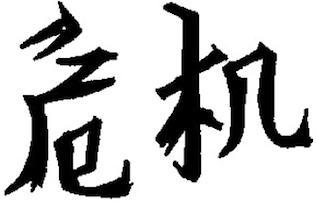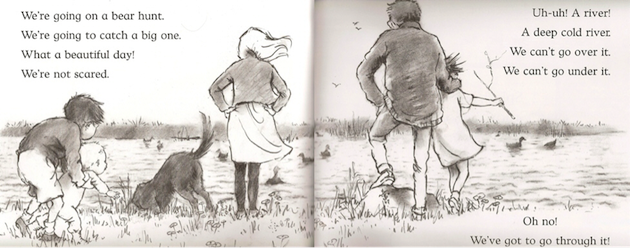Life without conflict is impossible. Everywhere we go, we find conflict in some form, be it international wars or hostile conference rooms. Conflict has been part of life since the dawn of humanity, and probably a lot earlier than that, if you can picture single-celled organisms battling it out for the best spot in the primordial ooze. But how we humans manage and move beyond conflict separates the kids from the grown-ups. (Though, in my career, I’ve witnessed grown men and women whose behavior rivaled a three-year-old, mid-meltdown.)
In design, as with most fields, some conflict is healthy. It ensures that bad ideas are tossed out and that the best and most innovative ideas rise to the top. We’ve all experienced conflict from various perspectives. Whether presenting and defending an idea, critiquing one you don’t agree with, or observing a conflict from afar, we live and work amidst constant conflict.
Interestingly, the word ‘conflict’ in Chinese consists of two symbols—one means danger and the other, opportunity. This is an elegant way of summing up the natural tension in the way people perceive conflict.
Most of us can tell when conflict isn’t managed effectively. Healthy creative banter is a beautiful thing, but it can turn into ugly, counter-productive posturing when opinions become closed, progress gives way to stagnation, and it becomes impossible to move beyond a disagreement. Getting unstuck requires more than rational thinking, it takes soft skills, self-awareness, and lots of practice.
So when does conflict turn the corner from beneficial to detrimental?
When Good Conflict Goes Bad
“I’m right. You’re wrong. The end.” It’s the workplace equivalent of our parents’ favorite saying: “Because I said so, that’s why!” A few years on the job and you’re sure to come in contact with That Person; the one who never gives in, the one who can turn a one-hour review into an unproductive waste of an afternoon, simply by refusing to gracefully give in to the collective wisdom of the group. It’s meetings like these that leave you asking yourself, “Is it bring your inner child to work day or what?”
In Bossypants, Tina Fey describes how each week’s sketches were selected during her years at Saturday Night Live. Once a week, the writers sat around a conference room table and read their pieces out loud. Then they voted on which were the funniest. In the chapter titled “I Don’t Care If You Like It” Fey writes: “It is an impressively arrogant move to conclude that just because you don’t like something, it is empirically not good. I don’t like Chinese food, but I don’t write articles trying to prove it doesn’t exist.” She is specifically addressing sexism and prejudice in the workplace, but the sentiment can be applied to all forms of conflict.
Around the SNL writer’s table, you could argue on behalf of your piece, or someone else’s, but in the end, the group decided together. That type of creative collaboration is what we all strive for. For most of us, letting go of our brilliant and groundbreaking ideas isn’t easy. For some of us, it’s impossible.
Fear of Peaceful Confrontation
With conflict being such an integral part of life, you’d think we’d all be better at dealing with it. Yet people often avoid confrontation. “Go along to get along,” we’re told. But when resentments build, relationships become strained. Imagined slights fester and become more exaggerated over time—as does one party’s animosity toward the other. This is often the case when the angry party is afraid of confronting the issue for some reason. Maybe they’re having difficulty with a stakeholder. Or perhaps a coworker is taking credit for their work.
Once an attitude of hostility sets in, however, the other party’s actions will always be viewed with suspicion. And in a workplace environment, this dynamic creates a toxic atmosphere that’s not conducive to collaboration or creativity.
When I find myself dreading a difficult conversation or a face-off, my self-administered pep talk always starts with: “What is the absolute worst thing that can happen if I say X?” Why lose sleep over the possibility of having an uncomfortable conversation? No matter how awkward the discussion turns out to be, I always feel better afterwards because I’ve voiced my opinion and shared my perspective. Done correctly, with respect for the other person’s experience of the situation, confrontation allows me to release tension or negativity before they build up and I explode.
Nietzsche sums it up in Beyond Good and Evil writing: “He who fights with monsters should look to it that he himself does not become a monster. And when you gaze long into an abyss the abyss also gazes into you.” Tyranny and bullying from the top can be effective, but that approach doesn’t work for long. Eventually, dictators are overthrown by their disgruntled subjects. Good leaders know great things happen when everyone is on board and committed to a common goal. Great leaders build consensus, work toward compromise, and deal with conflicts before they derail a project.
Ambassadors of Consensus
So, how can we deal with conflict in the workplace?
#1 Avoid it
(No, not by running out of the conference room if someone disagrees with you.) The easiest way to handle conflict is to take steps to prevent it in the first place, through careful planning and setting and resetting expectations. Create a safe, open atmosphere that encourages collaboration and communication.
#2 Embrace it
Stop being afraid of conflict and confrontation. They’re not going away any time soon. Sharing your thoughts and opinions is not by definition a hostile act. The sooner you bring the conflict out into the open, the sooner it can be resolved.
#3 Get through it
It’s funny what you can learn from children’s books. In Helen Oxenbury and Michael Rosen’s We’re Going on a Bear Hunt, when the family is confronted with a challenge, the theme is repeated “We can’t go over it. We can’t go under it. Oh, no! We’ve got to go through it!”
Handled well, a little confrontation can go a long way toward strengthening a relationship. If tensions have built up between you and another person, you can bet that you’re not the only one feeling it. Each time you reach out with the intention of resolving an ongoing conflict, you’re opening a door to opportunity and inviting the other party to step through it with you. You’re laying a foundation for a healthier relationship, which is essential to doing great work.
Advice From the Front Lines
So, how do you tackle a tough conversation when it heats up? First off, just like in high school, it pays to be popular. Meaning, you have the upper hand if people actually like you. You don’t have to be homecoming queen (or king), but when people enjoy working with you, they’re more likely to be able to handle the occasional disagreement with you, even a heated one. Of course, even if you’re the office pariah, you can still manage conflict, I promise.
Rather than view the confrontation as a battle, think of it as a peacekeeping mission. You’re there to give both parties a chance to air their opinions—and possibly their grievances. Listen and acknowledge other points of view. Express your own respectfully. Pretend that the success of your mission depends on finding a way to work together; because, actually, it does.
And remember, no matter how skilled you become at managing conflict, there still may be situations that end in an impasse. In these cases, unless forward progress is impeded by continuing disagreement, it’s acceptable to agree to disagree, as long as you know you’ve tried your hardest. The bottom line is that if stakeholders or colleagues are unable or unwilling to participate in open, good-spirited conflict resolution, then you can’t afford to keep them around. Sometimes the only thing to do is sever all ties, though clearly, this decision should be a last resort.
Cultivating Soft Skills
Unlike typing speed or spreadsheet prowess, it’s not easy to measure soft skills like leadership, self-motivation, and the ability to think critically. But we certainly recognize them when we see them in action, whether it’s the colleague who can calm the most anxious stakeholder with just a few words, or the coworker who can win an entire team to his side, seemingly by magic.
If you struggle with any of the skills mentioned above, don’t despair. Bookstore shelves are lined with numerous titles to help you fill in the gaps, including bestsellers like How to be Disagree Without Being Disagreeable: Getting Your Point Across with Gentle Art of Self-Defense by Suzette Hadin Elgin and Getting to Yes by Willam Ury and Bruce Patton. In Stephen Covey’s Seven Habits of Highly Effective People, he boils it down to this: “If I were to summarize in one sentence the single most important principle I have learned in the field of interpersonal relations, it would be this: Seek first to understand, then to be understood. This principle is the key to effective interpersonal communication.”
Better still, if you work with people who regularly display the skills you’d like to acquire, pay attention to how they work.
You can learn to handle conflict more effectively. As I mentioned before, understanding the inevitability of conflict can make it feel a little less distressing. When faced with a difficult situation, take a few steps back and ask yourself if you’re disagreeing on principle or because it really matters to the project. (i.e. is your ego getting in the way of a wise business decision?) Once you’re sure of your motivations, you can proceed to calmly and respectfully share your opinion with those who disagree.
Fight the Good Fight
Jason Fried, co-founder of 37Signals, says, “Conflict is a lot like water—it spills over; it flows downhill; and, if left unchecked, it erodes whatever it touches. And sometimes it’s like red wine, it stains.”
But that’s only when it’s not understood and not managed properly. Rather than fear conflict, we have to understand just how much we can learn from it. It’s not easy to think of conflict as a positive force in our lives, but the truth is, it can open the door to creativity, fresh ideas, and forward motion.
Image of bull and matador courtesy Anthon Jackson/Shutterstock.









